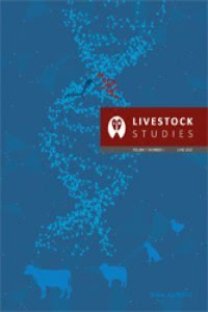TÜRKİYE’DE ESMER VE HOLŞTAYN SIĞIRLARINDA PROTEİN POLİMORFİZMİ VE BUNUN EBEVEYN KONTROLÜNDE KULLANIMI
Bu araştırma, Türkiye’de yetiştirilen bazı Esmer ve Holştayn sürülerinde Hb, Tf, Pa, Aml, Amll ve Cp fenotiplerini, bu fenotiplerin dağılımlarını ve allel frekanslarını tesbit etmek ve protein polimorfizminin ebeveyn kontrolündeki önemini ortaya koymak amacıyla yapılmıştır. Araştırmada 365 Esmer ve 165 Holştayn olmak üzere toplam 530 baş sığır ve bunların içerisinde yer alan 174 aile kullanılmıştır. Protein fenotipleri nişasta-Jel ve poliakrilamid-jel elektroforez yöntemleriyle tesbit edilmiştir. Irklara ait fenotipler ve allel genler belirlenmiş ve bunlara ait frekanslar hesaplanmıştır. Yapılan Khi-kare analizleri ile Holştaynlarda Aml, Amll ve Hb lokuslarının, Esmerlerde ise sadece Aml lokusunun Hardy-Weinberg kuralına uygunluk göstermediği saptanmıştır. Ceruloplasmin lokusunda polimorfizm bulunamamıştır. Ebeveyn testleri sonucunda, sistemler bağımsız olarak ele alındığında % 2.8 ile % 12 arasında hatalı kayıt bulunmuştur. Kombine sistem uygulandığında hatalı kayıt oranı % 18.4 olmuştur. Hatalı kayıtların ortaya çıkarılabilme ihtimali ise kombine sistem için % 65.7 olarak hesaplanmıştır. Ebeveyn kontrollerinde polimorfik protein sistemlerinin önemli bir araç olduğu anlaşılmıştır. Kombine sistemin kullanılması testin etkinliğini artırmıştır. Hata oranının azaltılmasında ilgili tüm personelin eğitilmesinin önemli rolü olacağı sonucuna varılmıştır.
Blood protein polymorphism and its use in parentage
test in dairy cattle breeds
The study was conducted to determine the phenotypes and allel frequencies of Hb, Tf, Pa, AmI, AmII and Cp in blood and to check their value in parentage tests. The material of the study consisted of 365 Turkish Brown and 165 Holstein cattle wihch constituted 174 family groups. Protein variants were determined by the methods of starch - gel and polyacrylamide - gel electrophoresis. The phenotype and allel frequencies were calculated. The distribution of Aml, Amll and Hb genotypes in Holsteins and Aml genotypes in Browns deviated significantly from the expected frequencies (P<0.01). No polymorphism was identified in the ceruloplasmin iocus in both breeds. Using the ploymorphic systems individually, 2.8 to 12 % pedigree errors were detected. When th systems combined, the rate of false pedigrees were increased to 18.4 %. According to the combined system, the exclusion probability was 65.7 percent It was concluded that the effectiveness of parentage tests could be rnaximised by using combined polymorphic system instead of individual systems. It may also be suggested that all the related personnel should be trained to minimise the possibility of pedigree errors.
